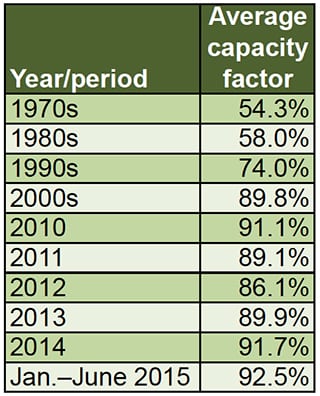U.S. Nuclear Plants Are Operating Better than Ever
The nation’s nuclear fleet has performed impressively through the first eight months of 2015.
Plant outages averaged less than 3% of total U.S. nuclear capacity during the all-important peak summer season this year—from June through August. The result is far better than even the lowest range of data from any of the past five years.
And it hasn’t just been a summer success story. During the spring maintenance season—a time when many plants conduct planned shutdowns for refueling and to get units in top condition for summer—outages averaged less than 15% of total U.S. nuclear capacity, also better than any other period from 2010 through 2014.
The data—compiled by the U.S. Energy Information Administration (EIA)—are consistent with the general trend in nuclear reliability and performance since the 1970s. An example of this is the improvement in average plant capacity factor (the ratio of actual generation to maximum potential generation) during that time, which has increased substantially (Table 1).
 |
| Table 1. Average annual U.S. nuclear fleet capacity factor. Source: U.S. EIA |
In 2014, the fleet set a record with only 59 unplanned automatic or manual reactor shutdowns. Although the numbers remain low so far this year, helping to boost capacity factors, some plants have had unexpected trouble.
The Pilgrim plant has seen its share of problems. The unit had to be taken offline in January during a blizzard when distribution lines failed and again in August when a broken air/nitrogen line caused a main steam isolation valve to close. Some other plants that experienced difficulty this summer include Indian Point Unit 3, which was forced offline by a main transformer fire in May, and the Callaway plant in Missouri, which had a reactor trip in August. Following the Callaway shutdown, a control valve failed to operate, leading to a special inspection by the Nuclear Regulatory Commission (NRC).
One factor that has helped boost capacity factors is that fewer plants are undergoing uprates this year. An uprate is when the power output of a plant is increased. As of April 2014, the NRC had approved 154 uprates, resulting in a total of 7,035 MW of additional generation.
To perform an uprate, a plant typically refuels with either slightly more enriched uranium or a higher percentage of new fuel. This enables the reactor to produce more thermal energy and therefore more steam. Components, such as pipes, valves, pumps, heat exchangers, electrical transformers, and generators, must also be able to accommodate the higher power level, which may involve major plant modifications, such as the replacement of main turbines. This work can require extended outages to perform, which hurts the plant’s capacity factor in the year of completion.
Shorter refueling outages have been another big driver toward higher capacity factors. Most reactors are refueled on 18- or 24-month cycles. Cutting days or weeks from these shutdown periods has allowed many plants to significantly improve capacity factors.
—Aaron Larson, associate editor (@AaronL_Power, @POWERmagazine)